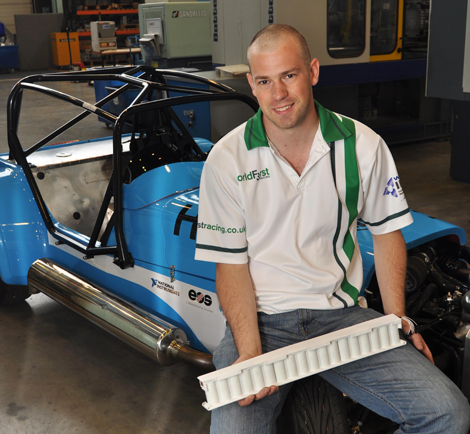
Stephen Lambert holding one of the laser-sintered plastic battery box modules that has helped to cut the 0 – 60 mph acceleration of the Westfield racing car from 5.5 to 3.5 seconds.
A plastic laser-sintering machine from EOS has solved the problem of how to extract maximum thrust from battery-powered motors driving the front wheels of a Westfield hybrid racing car. The project is being funded jointly by Warwick Innovative Manufacturing Research Centre and Potenza Technology, a specialist in hybrid and electric vehicle systems and owners of Westfield Sportscars based just a short 5 miles from where I live.

Doctor of Engineering postgraduate student, Stephen Lambert, a research engineer at Warwick Manufacturing Group, was asked by Westfield Sportscars to design a hybrid car that would accelerate faster. During consultations, this was what owner-drivers said they wanted above all other improvements. So a 1.6 litre / 200 brake horsepower petrol engine driving the rear wheels of a Westfield Sport Turbo 1600 was supplemented by fitting two electric motors, each rated at 75 kW / 100 BHP, to give the vehicle a four wheel drive boost for up to three minutes during a race. F1-style inboard suspension was added to drive the front wheels independently. The motors are brought into play by the driver pulling a pair of ‘push to pass’ paddles behind the steering wheel, the torque being blended in according to the throttle position.
To maximise both the power and the time that the electric drive is available to the front wheels, it is important to prevent excessive heating of the 396 lithium ion phosphate cells that supply the axial-flux motors. This was a challenge, as the only space available for the batteries was in the enclosure under the driver’s seat.
At the outset, Mr Lambert stored the cells in rows, side by side, in two battery boxes machined from solid plastic, one for each motor. However, an alternative was suggested by engineers from EOS, who are involved with the Formula Student project at Warwick Manufacturing Group. Instead of open battery boxes, two arrays of 11 plastic modules were designed so that each cell could be retained in its own cylindrical cavity, 18 per module.

CAD model of one of the battery boxes, comprising 11 modules each housing 18 lithium ion phosphate cells. Only two modules are shown with cells and busbars in place.
Rapid manufacturing in an EOSINT P-series laser-sintering machine, driven by data derived from slices taken through the CAD model of the new battery box, was used to produce the modules from layers of fused EOS PA 2200 polyamide powder. The flexibility of design afforded by this e-Manufacturing technique allowed air channels to be created between each cell cylinder and between adjacent modules as they are bolted together. This would not have been feasible by any other production method.The result is significantly enhanced cooling of the 3.6 volt cells due to air flowing around them while current of up to 100 amps is being drawn, boosting the performance of the batteries and hence of the electric motors.
Commented Mr Lambert, “By adding drive to the front wheels, we have managed to increase acceleration significantly. From a standing start, the Westfield Hybrid in four wheel drive mode achieves 60 mph in 3.5 seconds, compared with 5.5 seconds when only the rear wheels are driven. The bottom line is that an £8,000 adaptation of a £25,000 factory-built racing car delivers similar performance, albeit in short bursts, to that of top-end sports cars costing over £100,000, and with considerably reduced environmental impact.”
Goodwood Launch

The car’s launch was at the Goodwood Festival of Speed in July 2010. Now that the effectiveness of the hybrid design has been proven, the addition of front wheel drive could be a potential future upgrade for all owners of Westfield and other club racing cars looking for additional performance. Paul Faithfull, managing director of Potenza Technology, said, “The project has led to the robust design and manufacture of reliable battery solutions which could potentially be used in many platforms. By working closely with our partners, a system which performs to the highest standards of motorsport has been achieved.”
It is possible to run the Westfield Hybrid in electric-only mode. In fact, Westfield Sportscars and Potenza Technology have used the knowledge that Mr Lambert has gained from building the hybrid to develop a new, all-electric racing car, called iRacer. University of Warwick WMG Principal Fellow, Dr Steve Maggs, added, “Following the success of this prototype, there is potential for the system to be rolled out for production and sale by Westfield Sportscars. In fact, the system that has been developed is pioneering in that it can be integrated into any motor vehicle and therefore has numerous exciting potential applications in both motorsport and the automotive industry.”
Of course, if you’re interested in direct or rapid manufacturing techniques (and things are progressing massively), then a good place to start the learning process is TCT Live 2010, on this month at the Ricoh Arena in Coventry on the 19th and 20th October… Some of our team will be there abouts, so pop by and say hello.






